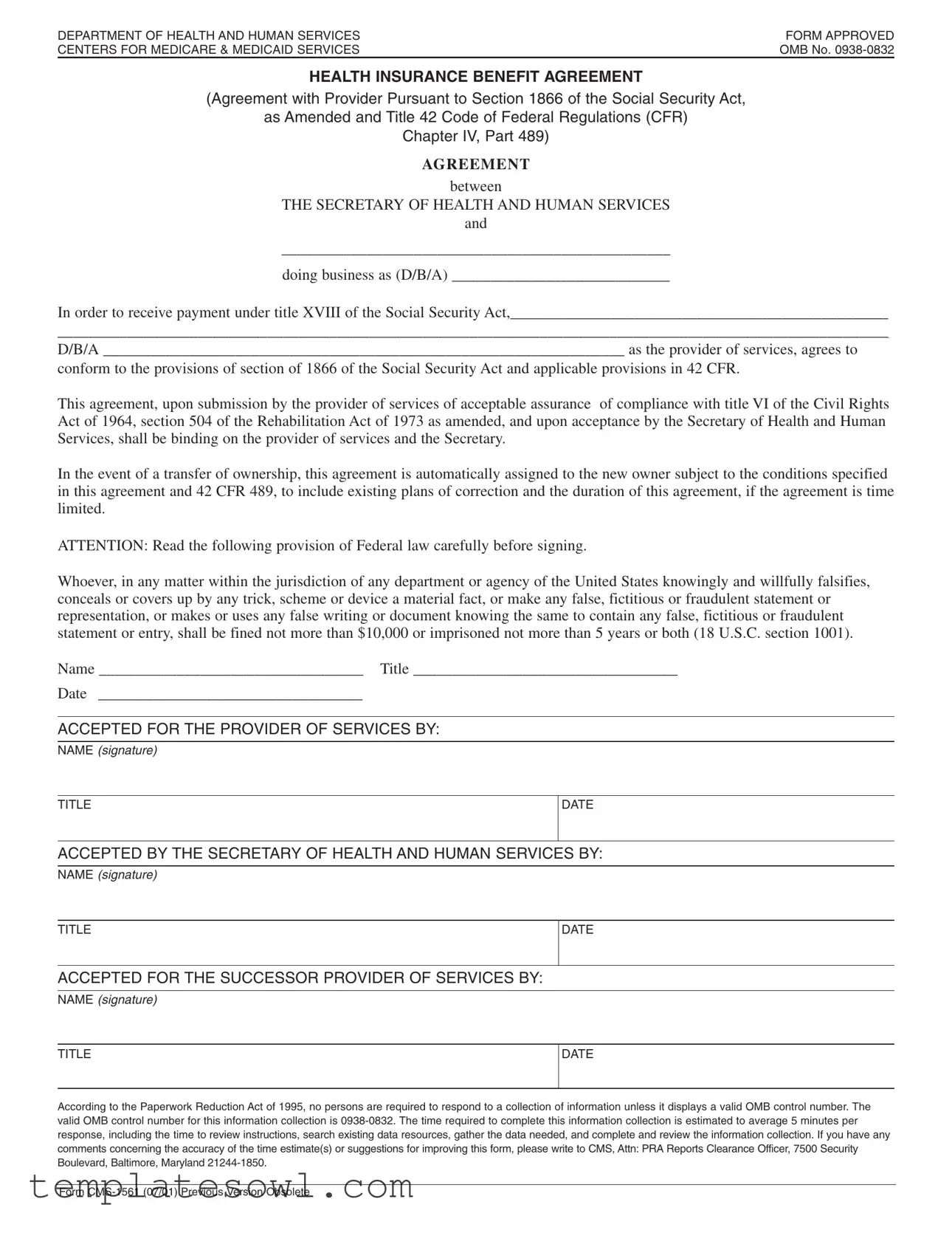
DEPARTMENT OF HEALTH AND HUMAN SERVICES |
FORM APPROVED |
CENTERS FOR MEDICARE & MEDICAID SERVICES |
OMB No. 0938-0832 |
HEALTH INSURANCE BENEFIT AGREEMENT
(Agreement with Provider Pursuant to Section 1866 of the Social Security Act,
as Amended and Title 42 Code of Federal Regulations (CFR)
Chapter IV, Part 489)
AGRE E ME NT
between
THE SECRETARY OF HEALTH AND HUMAN SERVICES
and
__________________________________________________
doing business as (D/B/A) ____________________________
In order to receive payment under title XVIII of the Social Security Act,_________________________________________________
___________________________________________________________________________________________________________
D/B/A ___________________________________________________________________ as the provider of services, agrees to
conform to the provisions of section of 1866 of the Social Security Act and applicable provisions in 42 CFR.
This agreement, upon submission by the provider of services of acceptable assurance of compliance with title VI of the Civil Rights Act of 1964, section 504 of the Rehabilitation Act of 1973 as amended, and upon acceptance by the Secretary of Health and Human Services, shall be binding on the provider of services and the Secretary.
In the event of a transfer of ownership, this agreement is automatically assigned to the new owner subject to the conditions specified in this agreement and 42 CFR 489, to include existing plans of correction and the duration of this agreement, if the agreement is time limited.
ATTENTION: Read the following provision of Federal law carefully before signing.
Whoever, in any matter within the jurisdiction of any department or agency of the United States knowingly and willfully falsifies, conceals or covers up by any trick, scheme or device a material fact, or make any false, fictitious or fraudulent statement or representation, or makes or uses any false writing or document knowing the same to contain any false, fictitious or fraudulent statement or entry, shall be fined not more than $10,000 or imprisoned not more than 5 years or both (18 U.S.C. section 1001).
Name __________________________________ Title __________________________________
Date __________________________________
ACCEPTED FOR THE PROVIDER OF SERVICES BY:
NAME (signature)
ACCEPTED BY THE SECRETARY OF HEALTH AND HUMAN SERVICES BY:
NAME (signature)
ACCEPTED FOR THE SUCCESSOR PROVIDER OF SERVICES BY:
NAME (signature)
According to the Paperwork Reduction Act of 1995, no persons are required to respond to a collection of information unless it displays a valid OMB control number. The valid OMB control number for this information collection is 0938-0832. The time required to complete this information collection is estimated to average 5 minutes per response, including the time to review instructions, search existing data resources, gather the data needed, and complete and review the information collection. If you have any comments concerning the accuracy of the time estimate(s) or suggestions for improving this form, please write to CMS, Attn: PRA Reports Clearance Officer, 7500 Security Boulevard, Baltimore, Maryland 21244-1850.
Form CMS-1561 (07/01) Previous Version Obsolete

